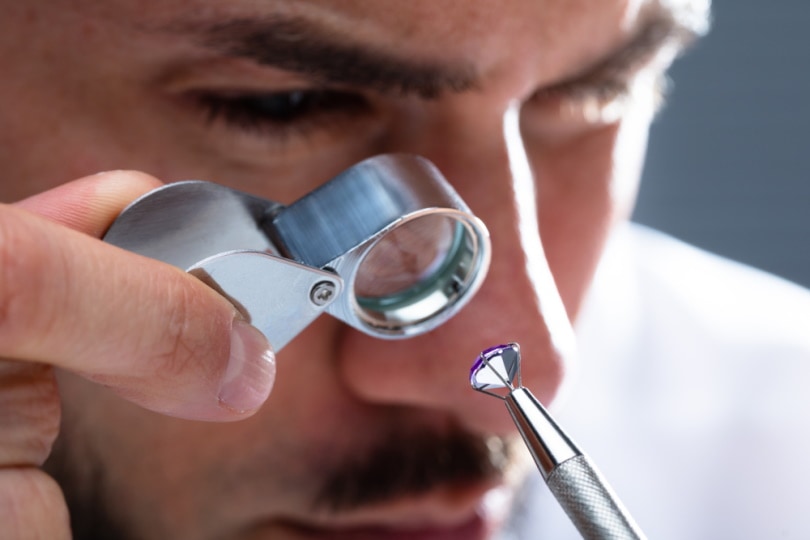How to Use a Jeweler’s Loupe: 5 Tips & Tricks
Last Updated on

Are you looking to get into the jewelry business, grade stones, or purchase a diamond? Have you wondered what a jeweler’s loupe is and how to use it? A jeweler’s loupe is used to certify that a diamond or other cut stones are not counterfeits. With a magnifier in the loupe, you can see fine details like the way the light is reflected, the color and clarity of the stone, or imperfections such as cracks. In this article, we’ll show you our 5 tips and tricks on using loupes, so you don’t have to worry about making a mistake.

Before You Start
Instead of instantly going into our first step, it’s important to take a few measures to ensure your viewing experience is adequate. We recommend cleaning your loupe by using a dust blower if there are any prominent dust specs on either side. Don’t forget to clean the actual gemstone itself as well, since there could be dirt or oil obstructing the clarity. Additionally, you’ll want to set up a light underneath where the stone will be viewed so the details of the object are well-lit.
How to Use a Jeweler’s Loupe – 5 Tips and Tricks
1. Open the Loupe

The first step you want to take when using a jeweler’s loupe is to open the metal latch that reveals the glass element. Most often, the cover will have its magnification inscribed on the surface. The industry standard is a 10x zoom. This requirement for grading gemstones was set by the Federal Trade Commission (FTC). In this case, anything more powerful will be unnecessary, but anything less powerful would be detrimental.
2. Hold the Loupe Correctly

Put the loupe you’re using directly in front of your preferred eye. Then, ensure the hand you’re holding the loupe with is placed correctly. In order to do this, you need to feel your knuckle touching against your cheek (the side you are holding the loupe with.) This will add stability so you can hold the loupe still and avoid unwanted shaking. You can also rest your elbow on something durable for further support.
3. Position the Gemstone Appropriately

With your off-hand, move your jewelry into the view of the loupe. It should be less than an inch away from the glass element. One thing to note is that you can use tweezers to hold your jewel, as it will prevent dust, oils, or grime from getting on the stone. Make sure to use locking tweezers; the material they’re made of shouldn’t be an issue for diamonds since they can only be scratched by other diamonds.
4. Look at the Face of the Gem

This is the fun part! You finally get to see the fine details, clarity, brilliance, and beauty of your diamond or other gemstones. Always start at the face of the jewel and then look from other positions to examine it further. Take all the time you need to check for impurities. Don’t forget to flip the tweezers around to view the bottom as well.
5. Grade the Stone

After you’ve gathered your visual results, compare this to the official grading standards to determine the gem’s value. Check for clarity or how high-quality the stone is (no imperfections or inclusions). Also, look at the color rating; diamonds should have as little color as possible. Diamonds with color variances can indicate impurities like the infusion of other elements. This may differ with diamonds that are specifically colored ( such as Black diamonds).

Conclusion
Loupes are an under-appreciated optical item and a necessary tool for both buyers and sellers to ensure their jewels are authentic. They inspect the most important aspects of a stone and can dictate its value. In any case, it’s a valuable skill to learn, and our helpful steps should provide the information you need to grab a loupe and get started!
Featured Image Credit: Andrey_Popov, Shutterstock
About the Author Robert Sparks
Robert’s obsession with all things optical started early in life, when his optician father would bring home prototypes for Robert to play with. Nowadays, Robert is dedicated to helping others find the right optics for their needs. His hobbies include astronomy, astrophysics, and model building. Originally from Newark, NJ, he resides in Santa Fe, New Mexico, where the nighttime skies are filled with glittering stars.
Related Articles:
How to Collimate Binoculars: 9 Expert Tips
How to Clean a Rifle Scope: 8 Expert Tips
Can You Use Binoculars to Look At Stars? How to Choose the Right Pair
How to Choose Binoculars for Bird Watching: 10 Expert Tips
How to Clean a Refractor Telescope: Step-by-Step Guide
How to Clean a Telescope Eyepiece: Step-by-Step Guide
Monocular vs Telescope: Differences Explained (With Pictures)
What Is a Monocular Used For? 8 Common Functions
